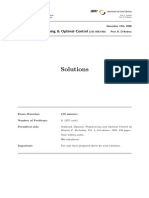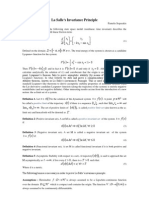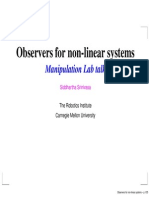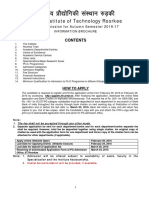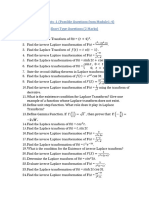Z Transform
Uploaded by
Suvra PattanayakZ Transform
Uploaded by
Suvra PattanayakZ-transform
Z-transform
In mathematics and signal processing, the Z-transform converts a discrete time-domain signal, which is a sequence of real or complex numbers, into a complex frequency-domain representation. It can be considered as a discrete-time equivalent of the Laplace transform. This similarity is explored in the theory of time scale calculus.
History
The basic idea now known as the Z-transform was known to Laplace, and re-introduced in 1947 by W. Hurewicz as a tractable way to solve linear, constant-coefficient difference equations.[1] It was later dubbed "the z-transform" by Ragazzini and Zadeh in the sampled-data control group at Columbia University in 1952.[2][3] The modified or advanced Z-transform was later developed and popularized by E. I. Jury.[4][5] The idea contained within the Z-transform is also known in mathematical literature as the method of generating functions which can be traced back as early as 1730 when it was introduced by de Moivre in conjunction with probability theory.[6] From a mathematical view the Z-transform can also be viewed as a Laurent series where one views the sequence of numbers under consideration as the (Laurent) expansion of an analytic function.
Definition
The Z-transform, like many integral transforms, can be defined as either a one-sided or two-sided transform.
Bilateral Z-transform
The bilateral or two-sided Z-transform of a discrete-time signal x[n] is the formal power series X(z) defined as
where n is an integer and z is, in general, a complex number:
where A is the magnitude of z, j is the imaginary unit, and phase) in radians.
is the complex argument (also referred to as angle or
Unilateral Z-transform
Alternatively, in cases where x[n] is defined only for n 0, the single-sided or unilateral Z-transform is defined as
In signal processing, this definition can be used to evaluate the Z-transform of the unit impulse response of a discrete-time causal system. An important example of the unilateral Z-transform is the probability-generating function, where the component is the probability that a discrete random variable takes the value , and the function is usually written as , in terms of . The properties of Z-transforms (below) have useful interpretations in the context of probability theory.
Z-transform
Geophysical definition
In geophysics, the usual definition for the Z-transform is a power series in as opposed to . This convention is used by Robinson and Treitel and by Kanasewich. The geophysical definition is
The two definitions are equivalent; however, the difference results in a number of changes. For example, the location of zeros and poles move from inside the unit circle using one definition, to outside the unit circle using the other definition. Thus, care is required to note which definition is being used by a particular author.
Inverse Z-transform
The inverse Z-transform is
where
is a counterclockwise closed path encircling the origin and entirely in the region of convergence (ROC). In must encircle all of the poles of . is the unit circle (and can be used when the ROC includes the is stable, i.e. all the poles are within the unit circle). The inverse
the case where the ROC is causal (see Example 2), this means the path A special case of this contour integral occurs when unit circle which is always guaranteed when
Z-transform simplifies to the inverse discrete-time Fourier transform:
The Z-transform with a finite range of n and a finite number of uniformly spaced z values can be computed efficiently via Bluestein's FFT algorithm. The discrete-time Fourier transform (DTFT) (not to be confused with the discrete Fourier transform (DFT)) is a special case of such a Z-transform obtained by restricting z to lie on the unit circle.
Region of convergence
The region of convergence (ROC) is the set of points in the complex plane for which the Z-transform summation converges.
Example 1 (no ROC)
Let . Expanding on the interval it becomes
Looking at the sum
Therefore, there are no values of
that satisfy this condition.
Z-transform
Example 2 (causal ROC)
Let function). Expanding it becomes Looking at the sum (where is the Heaviside step on the interval
The last equality arises from the infinite geometric series and the equality only holds if which can be rewritten in terms of Thus, the ROC is as .
. In this case the ROC is
the complex plane with a disc of radius 0.5 at the origin "punched out".
ROC shown in blue, the unit circle as a dotted grey circle (appears reddish to the eye) and the circle is shown as a dashed black circle
Example 3 (anticausal ROC)
Let interval Looking at the sum it becomes (where is the on the Heaviside step function). Expanding
Using the infinite geometric series, again, the equality only holds if which can be rewritten in terms of as . Thus, the ROC is
ROC shown in blue, the unit circle as a dotted grey circle and the circle is shown as a dashed black circle
. In this case the ROC is a disc centered at the origin and of radius 0.5.
What differentiates this example from the previous example is only the ROC. This is intentional to demonstrate that the transform result alone is insufficient.
Z-transform
Examples conclusion
Examples 2 & 3 clearly show that the Z-transform of is unique when and only when specifying the ROC. Creating the pole-zero plot for the causal and anticausal case show that the ROC for either case does not include the pole that is at 0.5. This extends to cases with multiple poles: the ROC will never contain poles. In example 2, the causal system yields an ROC that includes yields an ROC that includes . In systems with multiple poles it is possible to have an ROC that includes neither nor . The ROC creates a circular band. For example, has poles at 0.5 and 0.75. The ROC will be , which includes neither the origin nor infinity. Such a system is called a mixed-causality system as it contains a causal term and an anticausal term . The stability of a system can also be determined by knowing the ROC alone. If the ROC contains the unit circle (i.e., ) then the system is stable. In the above systems the causal system (Example 2) is stable because contains the unit circle. If you are provided a Z-transform of a system without an ROC (i.e., an ambiguous ) you can determine a unique Stability Causality If you need stability then the ROC must contain the unit circle. If you need a causal system then the ROC must contain infinity and the system function will be a right-sided sequence. If you need an anticausal system then the ROC must contain the origin and the system function will be a left-sided sequence. If you need both, stability and causality, all the poles of the system function must be inside the unit circle. The unique can then be found. provided you desire the following:
ROC shown as a blue ring
while the anticausal system in example 3
Properties
Properties of the z-transform
Time domain Notation Z-domain Proof ROC: ROC
Linearity
At least the intersection of ROC1 and ROC2
Z-transform
5
R^{1/k} : integer
Time expansion
Time shifting
ROC, except if and if
Scaling in the z-domain
Time reversal
Complex conjugation
ROC
Real part Imaginary part
ROC ROC
Differentiation
ROC
Convolution
At least the intersection of ROC1 and ROC2
Cross-correlation
At least the intersection of ROC of and
First difference
At least the intersection of ROC of X1(z) and
Accumulation
Multiplication
Z-transform
Parseval's relation
Initial value theorem , If Final value theorem , Only if poles of are inside the unit circle causal
Table of common Z-transform pairs
Here: is the unit (or Heaviside) step function
is the discrete-time (or Dirac delta) unit impulse function
Both are usually not considered as true functions but as distributions due to their discontinuity (their value on n=0 usually does not really matter, except when working in discrete time, in which case they become degenerate discrete series ; in this section they are chosen to take the value 1 on n=0, both for the continuous and discrete time domains, otherwise the content of the ROC column below would not apply). The two "functions" are chosen together so that the unit step function is the integral of the unit impulse function (in the continuous time domain), or the summation of the unit impulse function is the unit step function (in the discrete time domain), hence the choice of making their value on n=0 fixed here to 1.
Signal, 1 2 3 4 5 6 Z-transform, ROC
10
11
12
Z-transform
7
13 14
15
16
17
18
19
20
21
Relationship to Laplace transform
The Bilinear transform is a useful approximation for converting continuous time filters (represented in Laplace space) into discrete time filters (represented in z space), and vice versa. To do this, you can use the following substitutions in H(s) or H(z):
from Laplace to z (Tustin transformation), or
from z to Laplace. Through the bilinear transformation, the complex s-plane (of the Laplace transform) is mapped to the complex z-plane (of the z-transform). While this mapping is (necessarily) nonlinear, it is useful in that it maps the entire axis of the s-plane onto the unit circle in the z-plane. As such, the Fourier transform (which is the Laplace transform evaluated on the Fourier transform exists; i.e., that the axis) becomes the discrete-time Fourier transform. This assumes that the axis is in the region of convergence of the Laplace transform.
Process of sampling
Consider a continuous time signal . Its one sided Laplace transform is defined as :
If the continuous time signal
is uniformly sampled with a train of impulses to get a discrete time signal
, then it can be represented as:
where
is the sampling interval.
Now the Laplace transform of the sampled signal (discrete time) is called Star transform and is given by:
Z-transform
It can be seen that the Laplace transform of an impulse sampled signal is the star transform and is the same as the Z transform of the corresponding sequence when . Similar relationship holds when a continuous time system is converted into a sampled data system by cascading an actual impulse sampler at the input and a fictitious impulse sampler at the output.[7]
Relationship to Fourier transform
The Z-transform is a generalization of the discrete-time Fourier transform (DTFT). The DTFT can be found by evaluating the Z-transform at (where is the normalized frequency) or, in other words, evaluated on the unit circle. In order to determine the frequency response of the system the Z-transform must be evaluated on the unit circle, meaning that the system's region of convergence must contain the unit circle. This is the case where DTFT exists and converges uniformly, if unit circle is not in region of convergence of z-transform, but the signal is finite energy (not absolutely sumable) DTFT exists but converges only in mean square error, which means Gibbs phenomenon can happen. Also, using Dirac delta function, periodic signals which are not absolutely sumable can be represented in DTFT form.
Linear constant-coefficient difference equation
The linear constant-coefficient difference (LCCD) equation is a representation for a linear system based on the autoregressive moving-average equation.
Both sides of the above equation can be divided by equation can be written
, if it is not zero, normalizing
and the LCCD
This form of the LCCD equation is favorable to make it more explicit that the "current" output past outputs , current input , and previous inputs .
is a function of
Transfer function
Taking the Z-transform of the above equation (using linearity and time-shifting laws) yields
and rearranging results in
Z-transform
Zeros and poles
From the fundamental theorem of algebra the numerator has M roots (corresponding to zeros of H) and the denominator has N roots (corresponding to poles). Rewriting the transfer function in terms of poles and zeros
where
is the
zero and
is the
pole. The zeros and poles are commonly complex and when plotted on and . If we take these poles and zeros as well as
the complex plane (z-plane) it is called the pole-zero plot. In addition, there may also exist zeros and poles at multiple-order zeros and poles into consideration, the number of zeros and poles are always equal. By factoring the denominator, partial fraction decomposition can be used, which can then be transformed back to the time domain. Doing so would result in the impulse response and the linear constant coefficient difference equation of the system.
Output response
If such a system is driven by a signal then the output is . By performing can be found. In to generate a form partial fraction decomposition on and then taking the inverse Z-transform the output before multiplying that quantity by
practice, it is often useful to fractionally decompose of
which has terms with easily computable inverse Z-transforms.
References
[1] E. R. Kanasewich (1981). Time sequence analysis in geophysics (http:/ / books. google. com/ books?id=k8SSLy-FYagC& pg=PA185) (3rd ed.). University of Alberta. pp.185186. ISBN978-0-88864-074-1. . [2] J. R. Ragazzini and L. A. Zadeh (1952). "The analysis of sampled-data systems". Trans. Am. Inst. Elec. Eng. 71 (II): 225234. [3] Cornelius T. Leondes (1996). Digital control systems implementation and computational techniques (http:/ / books. google. com/ books?id=aQbk3uidEJoC& pg=PA123). Academic Press. p.123. ISBN978-0-12-012779-5. . [4] Eliahu Ibrahim Jury (1958). Sampled-Data Control Systems. John Wiley & Sons. [5] Eliahu Ibrahim Jury (1973). Theory and Application of the Z-Transform Method. Krieger Pub Co. ISBN0-88275-122-0. [6] Eliahu Ibrahim Jury (1964). Theory and Application of the Z-Transform Method. John Wiley & Sons. p.1. [7] Ogata, Katsuhiko. Discrete-Time Control Systems. India: Pearson Education. pp.7577,98103. ISBN81-7808-335-3.
Further reading
Refaat El Attar, Lecture notes on Z-Transform, Lulu Press, Morrisville NC, 2005. ISBN 1-4116-1979-X. Ogata, Katsuhiko, Discrete Time Control Systems 2nd Ed, Prentice-Hall Inc, 1995, 1987. ISBN 0-13-034281-5. Alan V. Oppenheim and Ronald W. Schafer (1999). Discrete-Time Signal Processing, 2nd Edition, Prentice Hall Signal Processing Series. ISBN 0-13-754920-2.
External links
Hazewinkel, Michiel, ed. (2001), "Z-transform" (http://www.encyclopediaofmath.org/index.php?title=p/ z130010), Encyclopedia of Mathematics, Springer, ISBN978-1-55608-010-4 Z-Transform table of some common Laplace transforms (http://www.swarthmore.edu/NatSci/echeeve1/Ref/ LPSA/LaplaceZTable/LaplaceZFuncTable.html) Mathworld's entry on the Z-transform (http://mathworld.wolfram.com/Z-Transform.html) Z-Transform threads in Comp.DSP (http://www.dsprelated.com/comp.dsp/keyword/Z_Transform.php) Z-Transform Module by John H. Mathews (http://math.fullerton.edu/mathews/c2003/ZTransformIntroMod. html)
Article Sources and Contributors
10
Article Sources and Contributors
Z-transform Source: http://en.wikipedia.org/w/index.php?oldid=533633213 Contributors: A multidimensional liar, Abdull, Albmont, Alejo2083, Andrei Stroe, AndrewKay, Andyjsmith, Apourbakhsh, Arroww, Arvindn, Ashkan2000, Bahram.zahir, BenFrantzDale, BeowulfNode, BigJohnHenry, Billymac00, Bjcairns, Boodlepounce, Cburnett, Charles Matthews, ChooseAnother, ChrisGualtieri, Clarkgwillison, Cplusplusboy, Crasshopper, Ctbolt, Daniel5Ko, Daveros2008, David Eppstein, Dicklyon, Dlituiev, Dspdude, E-boy, ESkog, Eleleszek, Eli Osherovich, Emperorbma, Epbr123, Foryayfan, Fred Bradstadt, Galorr, Gandalf61, GatoGalileo, Gene Ward Smith, Giftlite, Gligoran, Glrx, Gscshoyru, Guiermo, Hakeem.gadi, I dream of horses, IluvatarTheOne, Isarra (HG), Iulian.serbanoiu, JAIG, Jalanpalmer, Jatoo, Johnbanjo, Jtxx000, Jujutacular, Kenyon, Klilidiplomus, Kri, Kwamikagami, LachlanA, Larry V, Linas, LizardJr8, LokiClock, Lorem Ip, Lukaares, Mani excel, Mckee, Metacomet, Michael Hardy, Michael93555, Mitizhi, Mostafa mahdieh, Nejko, Neutiquam, Ninly, Nixdorf, NotWith, Oleg Alexandrov, Oli Filth, PAR, Peni, Peytonbland, Policron, Rabbanis, Rbehrns, Rbj, Rdrosson, Redhatter, Rgclegg, Robin48gx, SKvalen, Safulop, Salgueiro, Scls19fr, ShashClp, Sitar Physics, Slaunger, Smallman12q, SocratesJedi, Stevenj, Sverdrup, Taral, The Anome, TheDeadManCometh, Twinesurge, Ucgajhe, Unmitigated Success, Vegaswikian, Virtualphtn, Vizcarra, Wavelength, Weathercontrol@gmx.de, Wine Guy, Wireless friend, WordsOnLitmusPaper, Zama Zalotta, Zihengpan, Zvika, Zvn, 232 anonymous edits
Image Sources, Licenses and Contributors
Image:Region of convergence 0.5 causal.svg Source: http://en.wikipedia.org/w/index.php?title=File:Region_of_convergence_0.5_causal.svg License: Creative Commons Attribution-ShareAlike 3.0 Unported Contributors: en:User:Cburnett Image:Region of convergence 0.5 anticausal.svg Source: http://en.wikipedia.org/w/index.php?title=File:Region_of_convergence_0.5_anticausal.svg License: Creative Commons Attribution-ShareAlike 3.0 Unported Contributors: en:User:Cburnett Image:Region of convergence 0.5 0.75 mixed-causal.svg Source: http://en.wikipedia.org/w/index.php?title=File:Region_of_convergence_0.5_0.75_mixed-causal.svg License: Creative Commons Attribution-ShareAlike 3.0 Unported Contributors: en:User:Cburnett
License
Creative Commons Attribution-Share Alike 3.0 Unported //creativecommons.org/licenses/by-sa/3.0/
You might also like
- Computer Methods For Lunar Mission AnalysisNo ratings yetComputer Methods For Lunar Mission Analysis422 pages
- Appendix C Lorentz Group and The Dirac Algebra100% (1)Appendix C Lorentz Group and The Dirac Algebra13 pages
- The General Problem of Stability of MotionNo ratings yetThe General Problem of Stability of Motion18 pages
- Full Download Geometric Function Theory Explorations in Complex Analysis Cornerstones 1st Edition Steven G. Krantz PDF DOCX100% (6)Full Download Geometric Function Theory Explorations in Complex Analysis Cornerstones 1st Edition Steven G. Krantz PDF DOCX50 pages
- Distribution Theory Generalized Functions Notes: Ivan F WildeNo ratings yetDistribution Theory Generalized Functions Notes: Ivan F Wilde66 pages
- Control Principles For Engineered Systems 5SMC0: State Reconstruction & Observer DesignNo ratings yetControl Principles For Engineered Systems 5SMC0: State Reconstruction & Observer Design19 pages
- Z-Transform Analysis of Sampled-Data Control Systems Without Reference To Impulse Functions PDFNo ratings yetZ-Transform Analysis of Sampled-Data Control Systems Without Reference To Impulse Functions PDF4 pages
- Sliding Mode Control of An Inverted PendulumNo ratings yetSliding Mode Control of An Inverted Pendulum5 pages
- Principles of Engineering System Design: DR T Asokan Asok@iitm - Ac.i NNo ratings yetPrinciples of Engineering System Design: DR T Asokan Asok@iitm - Ac.i N23 pages
- Lab 6: Convolution Dee, Furc Lab 6: ConvolutionNo ratings yetLab 6: Convolution Dee, Furc Lab 6: Convolution6 pages
- Complete Quadratic Lyapunov Functionals Using Bessel LegendreInequalityNo ratings yetComplete Quadratic Lyapunov Functionals Using Bessel LegendreInequality6 pages
- Lab 03: Signals and Sequences: 3.1) Generating Sinusoidal WaveformsNo ratings yetLab 03: Signals and Sequences: 3.1) Generating Sinusoidal Waveforms8 pages
- A practical method for calculating largest Lyapunov exponents from small data sets100% (1)A practical method for calculating largest Lyapunov exponents from small data sets18 pages
- Introduction To Control: Dr. Muhammad Aamir Assistant Professor Bahria University IslamabadNo ratings yetIntroduction To Control: Dr. Muhammad Aamir Assistant Professor Bahria University Islamabad117 pages
- Optimal Control of Switching Times in Switched Dynamical SystemsNo ratings yetOptimal Control of Switching Times in Switched Dynamical Systems6 pages
- Property Periodic Signal Fourier Series Coefficients: k=−∞ k jkω t k=−∞ k jk (2π/T) tNo ratings yetProperty Periodic Signal Fourier Series Coefficients: k=−∞ k jkω t k=−∞ k jk (2π/T) t11 pages
- The Wavelet Tutorial Part III by Robi PolikarNo ratings yetThe Wavelet Tutorial Part III by Robi Polikar29 pages
- Use of Kalman Filters in Time and Frequency AnalysisNo ratings yetUse of Kalman Filters in Time and Frequency Analysis78 pages
- Transient Heat Conduction: Analytical MethodsNo ratings yetTransient Heat Conduction: Analytical Methods41 pages
- Fundamentals of Signals: 1.1 What Is A Signal?No ratings yetFundamentals of Signals: 1.1 What Is A Signal?22 pages
- 18 - Irreducible Tensor Operators and The Wigner-Eckart Theorem PDFNo ratings yet18 - Irreducible Tensor Operators and The Wigner-Eckart Theorem PDF30 pages
- Sliding Mode Control Strategy For A 6 DOF Quadrotor HelicopterNo ratings yetSliding Mode Control Strategy For A 6 DOF Quadrotor Helicopter7 pages
- GEG 402 Slides of Numerical Analysis of Ordinary Differential Equations 3100% (1)GEG 402 Slides of Numerical Analysis of Ordinary Differential Equations 354 pages
- Jacob Millman, Arvin Grabel - Microelectronics-McGraw-Hill (1987) PDFNo ratings yetJacob Millman, Arvin Grabel - Microelectronics-McGraw-Hill (1987) PDF1,030 pages
- CBSE Class 12 Maths Notes - Indefinite Integrals - AglaSem SchoolsNo ratings yetCBSE Class 12 Maths Notes - Indefinite Integrals - AglaSem Schools15 pages
- Power System Dynamics Simulation Tutorial 1No ratings yetPower System Dynamics Simulation Tutorial 19 pages
- 1st Stage CBT (Common For All Notified Posts of This CEN) : Duration: 90 Minutes No of Questions: 100No ratings yet1st Stage CBT (Common For All Notified Posts of This CEN) : Duration: 90 Minutes No of Questions: 1002 pages
- Registration Form: National Institute of Technology RourkelaNo ratings yetRegistration Form: National Institute of Technology Rourkela3 pages
- 1st Stage CBT (Common For All Notified Posts of This CEN) : Duration: 90 Minutes No of Questions: 100No ratings yet1st Stage CBT (Common For All Notified Posts of This CEN) : Duration: 90 Minutes No of Questions: 1002 pages
- To The Principal, Industrial Training Institute Jhargram P O: Jhargram Dist: Paschim MedinipurNo ratings yetTo The Principal, Industrial Training Institute Jhargram P O: Jhargram Dist: Paschim Medinipur1 page
- Computation of The DFT of Real SequencesNo ratings yetComputation of The DFT of Real Sequences45 pages
- X X F X X: UNIT I (8 Marks) Fourier SeriesNo ratings yetX X F X X: UNIT I (8 Marks) Fourier Series14 pages
- Laboratory Exercise 3: Discrete-Time Signals: Frequency-Domain RepresentationsNo ratings yetLaboratory Exercise 3: Discrete-Time Signals: Frequency-Domain Representations49 pages
- Laboratory Exercise 3: Discrete-Time Signals: Frequency-Domain RepresentationsNo ratings yetLaboratory Exercise 3: Discrete-Time Signals: Frequency-Domain Representations25 pages
- Fast Fourier Transform: Key Papers in Computer Science Seminar 2005 Dima BatenkovNo ratings yetFast Fourier Transform: Key Papers in Computer Science Seminar 2005 Dima Batenkov90 pages
- Course No Course Title Instructor-In-ChargeNo ratings yetCourse No Course Title Instructor-In-Charge3 pages
- Name: Madhankumar.S REG NO: 15BEE0305 Roll No: Title of The Assignment: Subject: Digital Signal Processing Faculty: Mahalakshmi.PNo ratings yetName: Madhankumar.S REG NO: 15BEE0305 Roll No: Title of The Assignment: Subject: Digital Signal Processing Faculty: Mahalakshmi.P7 pages
- The DFT FFT and Practical Spectral Analysis 2.1No ratings yetThe DFT FFT and Practical Spectral Analysis 2.1106 pages
- DTFS (Synthesis FS) : Fourier Spectra of A Periodic SignalNo ratings yetDTFS (Synthesis FS) : Fourier Spectra of A Periodic Signal2 pages
- Ece 232 Discrete-Time Signals and Systems Solved Problems I: DT e T X T C and e C T XNo ratings yetEce 232 Discrete-Time Signals and Systems Solved Problems I: DT e T X T C and e C T X4 pages
- UNIT - 3: Fast-Fourier-Transform (FFT) Algorithms: Dr. Manjunatha. PNo ratings yetUNIT - 3: Fast-Fourier-Transform (FFT) Algorithms: Dr. Manjunatha. P100 pages
- Magnus, W. - Oberhettinger, F. - Formulas & Theorems For The Functions of Mathematical Physics. CheNo ratings yetMagnus, W. - Oberhettinger, F. - Formulas & Theorems For The Functions of Mathematical Physics. Che178 pages
- Full Download Geometric Function Theory Explorations in Complex Analysis Cornerstones 1st Edition Steven G. Krantz PDF DOCXFull Download Geometric Function Theory Explorations in Complex Analysis Cornerstones 1st Edition Steven G. Krantz PDF DOCX
- Distribution Theory Generalized Functions Notes: Ivan F WildeDistribution Theory Generalized Functions Notes: Ivan F Wilde
- Control Principles For Engineered Systems 5SMC0: State Reconstruction & Observer DesignControl Principles For Engineered Systems 5SMC0: State Reconstruction & Observer Design
- Z-Transform Analysis of Sampled-Data Control Systems Without Reference To Impulse Functions PDFZ-Transform Analysis of Sampled-Data Control Systems Without Reference To Impulse Functions PDF
- Principles of Engineering System Design: DR T Asokan Asok@iitm - Ac.i NPrinciples of Engineering System Design: DR T Asokan Asok@iitm - Ac.i N
- Complete Quadratic Lyapunov Functionals Using Bessel LegendreInequalityComplete Quadratic Lyapunov Functionals Using Bessel LegendreInequality
- Lab 03: Signals and Sequences: 3.1) Generating Sinusoidal WaveformsLab 03: Signals and Sequences: 3.1) Generating Sinusoidal Waveforms
- A practical method for calculating largest Lyapunov exponents from small data setsA practical method for calculating largest Lyapunov exponents from small data sets
- Introduction To Control: Dr. Muhammad Aamir Assistant Professor Bahria University IslamabadIntroduction To Control: Dr. Muhammad Aamir Assistant Professor Bahria University Islamabad
- Optimal Control of Switching Times in Switched Dynamical SystemsOptimal Control of Switching Times in Switched Dynamical Systems
- Property Periodic Signal Fourier Series Coefficients: k=−∞ k jkω t k=−∞ k jk (2π/T) tProperty Periodic Signal Fourier Series Coefficients: k=−∞ k jkω t k=−∞ k jk (2π/T) t
- Use of Kalman Filters in Time and Frequency AnalysisUse of Kalman Filters in Time and Frequency Analysis
- 18 - Irreducible Tensor Operators and The Wigner-Eckart Theorem PDF18 - Irreducible Tensor Operators and The Wigner-Eckart Theorem PDF
- Sliding Mode Control Strategy For A 6 DOF Quadrotor HelicopterSliding Mode Control Strategy For A 6 DOF Quadrotor Helicopter
- GEG 402 Slides of Numerical Analysis of Ordinary Differential Equations 3GEG 402 Slides of Numerical Analysis of Ordinary Differential Equations 3
- Jacob Millman, Arvin Grabel - Microelectronics-McGraw-Hill (1987) PDFJacob Millman, Arvin Grabel - Microelectronics-McGraw-Hill (1987) PDF
- CBSE Class 12 Maths Notes - Indefinite Integrals - AglaSem SchoolsCBSE Class 12 Maths Notes - Indefinite Integrals - AglaSem Schools
- 1st Stage CBT (Common For All Notified Posts of This CEN) : Duration: 90 Minutes No of Questions: 1001st Stage CBT (Common For All Notified Posts of This CEN) : Duration: 90 Minutes No of Questions: 100
- Registration Form: National Institute of Technology RourkelaRegistration Form: National Institute of Technology Rourkela
- 1st Stage CBT (Common For All Notified Posts of This CEN) : Duration: 90 Minutes No of Questions: 1001st Stage CBT (Common For All Notified Posts of This CEN) : Duration: 90 Minutes No of Questions: 100
- To The Principal, Industrial Training Institute Jhargram P O: Jhargram Dist: Paschim MedinipurTo The Principal, Industrial Training Institute Jhargram P O: Jhargram Dist: Paschim Medinipur
- Laboratory Exercise 3: Discrete-Time Signals: Frequency-Domain RepresentationsLaboratory Exercise 3: Discrete-Time Signals: Frequency-Domain Representations
- Laboratory Exercise 3: Discrete-Time Signals: Frequency-Domain RepresentationsLaboratory Exercise 3: Discrete-Time Signals: Frequency-Domain Representations
- Fast Fourier Transform: Key Papers in Computer Science Seminar 2005 Dima BatenkovFast Fourier Transform: Key Papers in Computer Science Seminar 2005 Dima Batenkov
- Name: Madhankumar.S REG NO: 15BEE0305 Roll No: Title of The Assignment: Subject: Digital Signal Processing Faculty: Mahalakshmi.PName: Madhankumar.S REG NO: 15BEE0305 Roll No: Title of The Assignment: Subject: Digital Signal Processing Faculty: Mahalakshmi.P
- DTFS (Synthesis FS) : Fourier Spectra of A Periodic SignalDTFS (Synthesis FS) : Fourier Spectra of A Periodic Signal
- Ece 232 Discrete-Time Signals and Systems Solved Problems I: DT e T X T C and e C T XEce 232 Discrete-Time Signals and Systems Solved Problems I: DT e T X T C and e C T X
- UNIT - 3: Fast-Fourier-Transform (FFT) Algorithms: Dr. Manjunatha. PUNIT - 3: Fast-Fourier-Transform (FFT) Algorithms: Dr. Manjunatha. P
- Magnus, W. - Oberhettinger, F. - Formulas & Theorems For The Functions of Mathematical Physics. CheMagnus, W. - Oberhettinger, F. - Formulas & Theorems For The Functions of Mathematical Physics. Che
